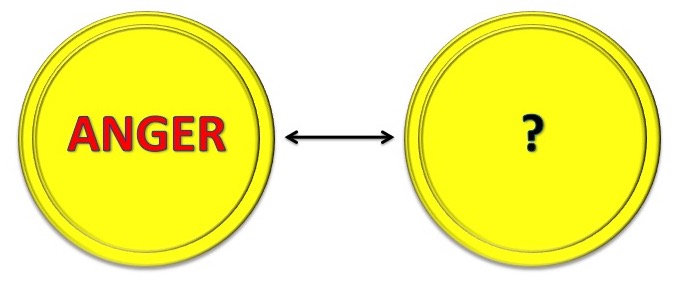In Part 1 of Dealing with Anger, we explored the “WHAT” aspect of Dealing with ANGER. That is important because before we can deal with ANGER, or anything for that matter, we need to first understand what it is, so we can overcome it effectively.
In Part 2, we will look at the “WHY” aspect. Why do we get angry? Why do we choose ANGER over whatever it is covering up?
Why is there ANGER in the First Place?
In the previous part, we have seen that ANGER exists to protect us. But how does our body or brain know we need protection? It is because ANGER is the response we have to things that fall outside our OB markers. And things fall outside our OB markers because we deem them bad, dangerous etc. They are things that could threaten our well being.
Some people may say they get angry at things that are wrong, not when they are in danger.
Well, why would we consider anything wrong? It’s when those things, behaviour, etc break certain rules or decorum. And what happens when rules or social sensibilities are broken? If EVERYONE follows suit and decides to do the wrong thing, there will be disorder and suffering. All hell can break loose, and our well being will be threatened.
Hence, if we decode ANGER a little deeper, we will realise that ANGER is actually triggered by FEAR. ANGER is a mask for FEAR.
The question is, why does FEAR need a mask in the first place?
What Happens When We Are Gripped By FEAR?
When we are gripped by fear, most of us feel our hearts suddenly turning cold. We feel blood draining from our faces and our limbs, especially our legs turning to jelly or lead. Our minds suddenly go blank and we don’t know what we do. Instinctively, most of us feel like crouching into a fetal position and staying there.
Why Does Our Body React That Way To FEAR?
Interestingly, like ANGER, FEAR also triggers a rush of adrenaline into our bodies. But unlike ANGER which leads to quickening of our breaths and gushing of blood to our face and head, FEAR leads to blood being drained from all our extremities back into our core (or trunk). That’s why we feel our hearts turn cold, our limbs feel heavy and we freeze up. Yet, instinctively, we know we need to survive if we were attacked. Hence, we feel the urge to curl up like a fetus so we can protect our core.
Anger and Fear: Two Sides of the Same Coin
Both ANGER and FEAR trigger the release of adrenaline.
Unlike ANGER which prepares us to act against the danger, FEAR makes us freeze so we appear invisible to the danger. Both emotions are necessary for our survival.
Unfortunately, our society sees inaction, or freezing, as cowardly. So we, humans, begin to associate FEAR as “useless”. As a result, we tend to convert FEAR to ANGER since the latter makes us appear stronger and gives the sense that we are doing something about the danger.
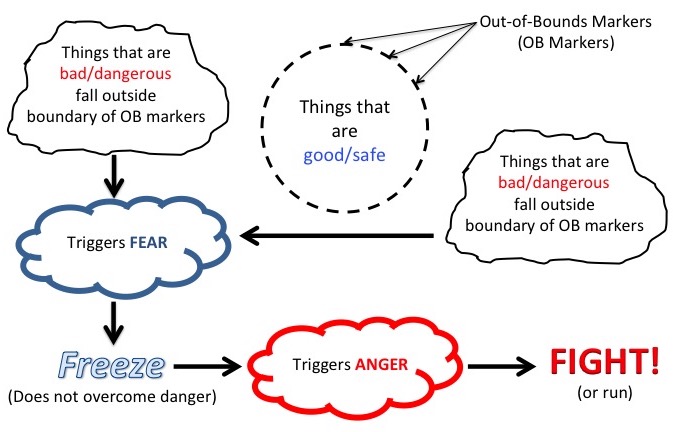
Therefore, ANGER is the “proactive” twin of FEAR. FEAR makes us shut down. ANGER makes us act against (be it run or fight) whatever it is that we fear. They are two sides of the same coin.

How Does It Apply To Parenting?
Now, imagine our children have been constantly distracted by their electronic devices. We know they can do well in school if they put in the effort but they just don’t seem to care. And their results show they have done badly.
In this case, most parents will explode in anger. Some may scold their kids and some may add caning or hitting to the punishment. Why?
The reason is simple. We fear that our children will end up doing low-paying menial work instead of high-paying jobs. In other words, we fear for their future. But, as we know, FEAR is useless, non-productive. Freezing and not doing anything is not an option. Hence, most parents will naturally and instinctively turn that FEAR into ANGER so they have an emotion that will help them DO something. That’s why parents will yell and hit their children. They think they are doing it out of love to help their children amend their ways. But actually, they are releasing the FEAR that has gripped their heart by exhibiting ANGER.
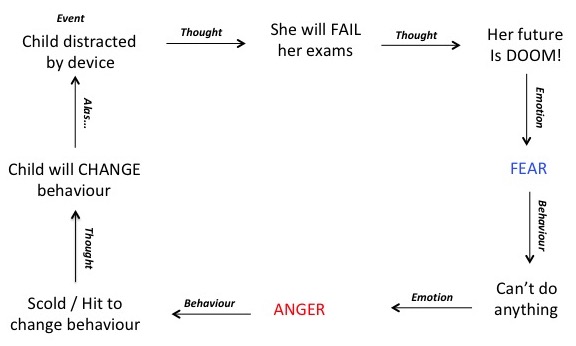
When something happens, our mind interprets it and depending on our interpretation, an emotion arises which leads to a behaviour.But if the first emotion is deemed ineffective, gradually, our minds do not even register them (faded in the diagram below) and register only the resulting emotion. That’s when we feel as if we went straight from seeing our child distracted by his device to the thought her future is DOOMED to feeling ANGER and acting angry.
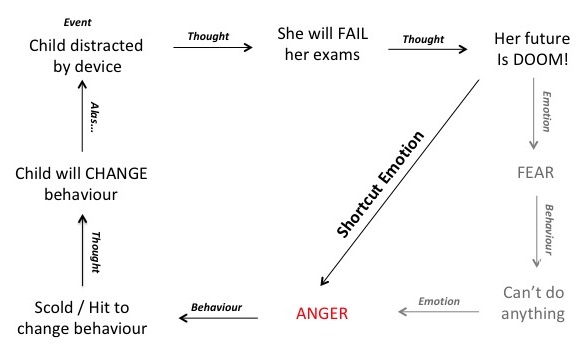
What other FEARS do we have that we have masked with ANGER?
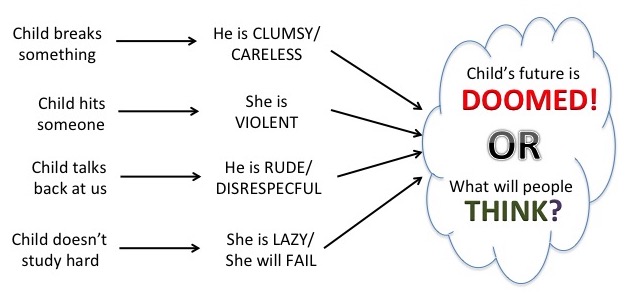
Most of the anger we have against our children boils down to our fear for their future. Some of it could be due to our fear of losing our own sanity or our fear of “losing face”. And our greatest fear is actually not death, but the fear that we are NOT GOOD ENOUGH. That’s why people are very easily triggered when they feel they “lose face”.
Conclusion
Now we understand what ANGER is, what it masks and why we turn to ANGER when what we actually feel is FEAR. In the third part of the Dealing with Anger, we shall look at what are some of the strategies we can use to control anger.
Till then, continue analysing why you get angry and get to the root fear that triggered the anger. Awareness is the first step. Once you can identify a pattern in the fear, it will be easier to address it. But that’d be a separate post. ;P
If you have enjoyed the Dealing with Anger series so far and have found it helpful, please share it with your friends. Thank you all for spreading the love and awareness! And if you haven’t already liked Decoding Your Child, do click “LIKE”.
Happy Parenting!!
Update: You can read the other parts of the series here:
Part 1: What is Anger?
Part 3: How to Overcome Anger

